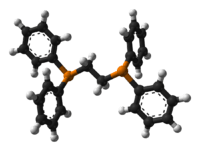1,2-Bis(diphenylphosphino)ethane
 | |
 | |
| Names | |
|---|---|
| IUPAC name
Ethane-1,2-diylbis(diphenylphosphane) | |
| Other names
1,2-Bis(diphenylphosphino)ethane Diphos Dppe | |
| Identifiers | |
| 1663-45-2 | |
| 3D model (Jmol) | Interactive image Interactive image |
| ChEBI | CHEBI:30669 |
| ChEMBL | ChEMBL68683 |
| ChemSpider | 66873 |
| ECHA InfoCard | 100.015.246 |
| |
| |
| Properties | |
| C26H24P2 | |
| Molar mass | 398.42 g/mol |
| Melting point | 140 to 142 °C (284 to 288 °F; 413 to 415 K) |
| Except where otherwise noted, data are given for materials in their standard state (at 25 °C [77 °F], 100 kPa). | |
| | |
| Infobox references | |
1,2-Bis(diphenylphosphino)ethane (dppe) is a commonly used bidentate ligand in coordination chemistry. Dppe is almost invariably chelating, although there are examples of monodentate (e.g., W(CO)5(dppe)) and of bridging behavior.[1]
Preparation
The preparation of dppe is conducted via the alkylation of NaPPh2 which is typically prepared from triphenylphosphine (P(C6H5)3) as follows:[2][3]
- 1. P(C6H5)3 + 2 Na → NaP(C6H5)2 + NaC6H5
NaP(C6H5)2, which is readily air-oxidized, is treated with 1,2-dichloroethane (ClCH2CH2Cl) to give dppe:
- 2. 2 NaP(C6H5)2 + ClCH2CH2Cl → (C6H5)2PCH2CH2P(C6H5)2 + 2 NaCl
Reactions
Reduction
The reduction of dppe by lithium to give PhHP(CH2)2PHPh has been reported.[4]
- 1. Ph2P(CH2)2PPh2 + 4 Li → PhLiP(CH2)2PLiPh + 2 PhLi
Hydrolysis by water gives:
- 2. PhLiP(CH2)2PLiPh + 2 PhLi + 4H2O → PhHP(CH2)2PHPh + 4 LiOH + 2C6H6
Oxidation
Treatment of dppe with conventional oxidants such as hydrogen peroxide (H2O2), aqueous bromine (Br2), etc., always produces dppeO in low yield (e.g., 13%) as a result of non-selective oxidation leading to mixtures of the starting material, the monoxide, and dioxide.[5] Selective mono-oxidation of dppe can be achieved by reaction with PhCH2Br to give dppeO.
- 3. Ph2P(CH2)2PPh2 + PhCH2Br → Ph2P(CH2)2PPh2(CH2Ph)+Br−
This is followed by purification and alkaline catalyzed hydrolysis of the mono-phosphonium salt.
- 4. Ph2P(CH2)2PPh2(CH2Ph)+Br− + NaOH + H2O → Ph2P(CH2)2P(O)Ph2
Hydrogenation
Hydrogenation of dppe gives the ligand bis(dicyclohexylphosphino)ethane.
Coordination chemistry
-3D-balls.png)
Coordination complexes of dppe, and diphosphine ligands in general, are almost entirely used as homogeneous catalysts for a wide range of reactions. Two simple coordination complexes of dppe include Pd(dppe)2 and Ir(dppe)2. Pd(dppe)2 can be prepared by reduction of Pd(II) with NaBH4. It is most conveniently prepared, however, in situ from Pd(OAc)2.[5]
References
- ↑ Cotton, F.A.; Wilkinson, G. Advanced Inorganic Chemistry: A Comprehensive Text, 4th ed.; Wiley-Interscience Publications: New York, NY, 1980; p.246. ISBN 0-471-02775-8
- ↑ W. Hewertson and H. R. Watson (1962). "283. The preparation of di- and tri-tertiary phosphines". J. Chem. Soc.: 1490–1494. doi:10.1039/JR9620001490.
- ↑ Girolami, G.; Rauchfuss, T.; Angelici, R. Synthesis and Technique in Inorganic Chemistry, 3rd ed.; University Science Books: Sausalito, CA, 1999; pp. 85-92. ISBN 0-935702-48-2
- ↑ Dogan, J.; Schulte, J.B.; Swiegers, G.F.; Wild, S.B. (2000). "Mechanism of Phosphorus-Carbon Bond Cleavage by Lithium in Tertiary Phosphines. An Optimized Synthesis of 1, 2-Bis (phenylphosphino) ethane". J. Org. Chem. 65 (4): 951–957. doi:10.1021/jo9907336.
- 1 2 Encyclopedia of Reagents for Organic Synthesis 2001 John Wiley & Sons, Ltd
